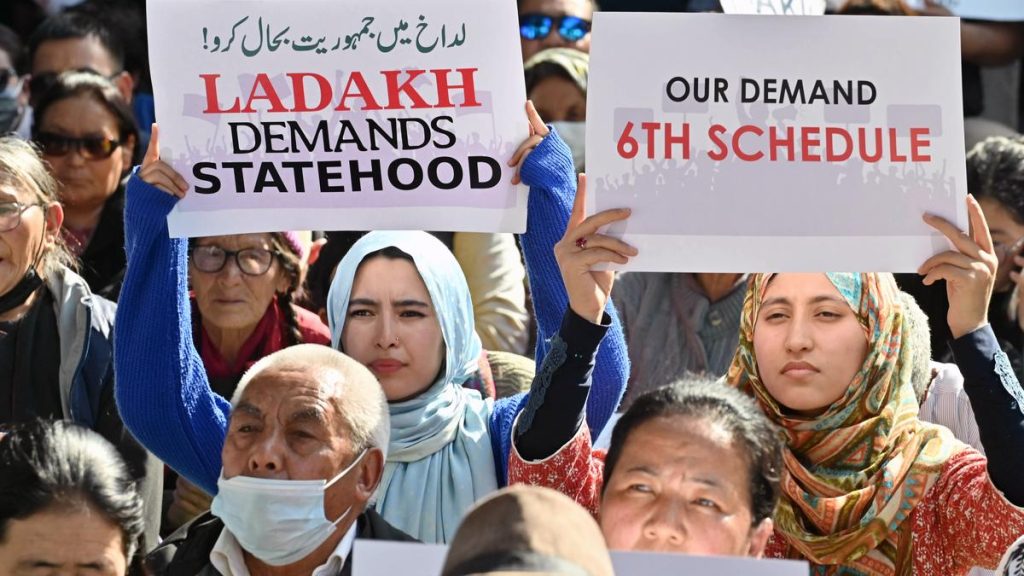Syllabus:
GS-2: Functions and responsibilities of the Union and the States, issues and challenges pertaining to the federal structure, devolution of powers and finances up to local levels and challenges therein.
Context: A month after police action in Leh city, civil groups resumed talks with the Union Home Ministry (MHA) officials on Ladakh’s statehood demand.
More on the News
• MHA officials informed the Leh Apex Body (LAB) and Kargil Democratic Alliance (KDA) that special provisions under Article 371 could be considered for Ladakh.
• However, both groups continued to demand inclusion under the Sixth Schedule of the Constitution.
Current Constitutional Status of Ladakh
• Ladakh is one of India’s newest Union Territories, formed in 2019 after the bifurcation of Jammu and Kashmir.
• The high-altitude region comprises two districts—Leh, which is predominantly Buddhist, and Kargil, largely populated by Shia Muslims.
• It does not have its own legislature placing it under direct control of the Lieutenant Governor and the Centre.
Historical Background:
• Demands for Ladakh’s autonomy can be traced back to the 1950s just after Independence, on to the formation of the Ladakh Buddhist Association in the 1970s, before pivoting to the ask for UT status in 1989.
• The National Commission for Scheduled Tribes (NCST) had written to the government in 2019, recommending the inclusion of Ladakh under Sixth Schedule.
- It had pointed out that “total tribal population in Ladakh region is more than 97 percent”, adding that Sixth Schedule would allow for “democratic devolution of powers”, besides preserving Ladakh’s “culture, protect land rights”, and “enhance transfer of funds for speedy development”.
- The 97% figure includes not just the Buddhists of Leh, but also the Shia Muslim tribals of Kargil, such as the Baltis and Purigpas, among others.
- The Arghons of Leh, a Sunni Muslim community, are listed under the general category.
• Post Jammu and Kashmir reorganisation in 2019, Ladakh residents realised they had lost the protection that they had under Article 370.
• In 2021, the Leh Apex Body (LAB) and the Kargil Democratic Alliance (KDA) came together to voice the demands for statehood, constitutional safeguards under Sixth Schedule, separate Lok Sabha seats for Leh and Kargil districts, and job reservation for local residents.
Article 371
• Article 371 deals with “Temporary, Transitional and Special Provisions”, and exists under Part XXI of the Constitution.
• It is currently applicable in 12 States which are Nagaland, Assam, Manipur, Mizoram, Maharashtra, Gujarat, Andhra Pradesh, Telangana, Arunachal Pradesh, Goa, Sikkim, and Karnataka.
• Key Features:
- The objective is to meet regional aspirations, protect local culture and tribal interests, ensure development equity, and sometimes address law and order problems.
- The provisions may include restrictions on land transfer to outsiders, protection of local customs, reservation in jobs, and special administrative powers for governors or councils.
- Article 371(A-J) gives varying degrees of autonomy and protection over local laws, customs, and resource management.
Sixth Schedule
• The Sixth Schedule provides for the administration of tribal areas in Assam, Meghalaya, Tripura, and Mizoram through Autonomous District Councils (ADCs) and Regional Councils.
• Key Features:
- Autonomous governance: The schedule creates Autonomous Districts and Regions to administer tribal areas with self-governing powers.
- Councils’ structure: District and Regional Councils are established to manage local affairs with varying degrees of autonomy.
- Governor’s authority: The Governor can create, modify, or rename districts and regions.
- Legislative and executive powers: Councils can make laws on land, forests, inheritance, and customs, and manage local institutions like schools, markets, and roads.
- Judicial powers: They can establish courts to administer justice based on tribal laws and traditions.
- Financial autonomy: Councils can levy taxes and control their own budgets.
- Application of laws: State and central laws may not apply or may apply with modifications in these autonomous areas.

